Photographer Tom Hunter stages modernized adaptations of paintings by such icons as Vermeer, Manet and the Pre-Raphaelites by using models and settings from Hackney, the London neighborhood where he has lived for the past 20 years. He also draws upon the Hackney Gazette, the local weekly paper whose clever and sensationalistic tabloid headlines give him titles and narratives for many of his stunning and disquieting images. When Hunter arrived in Hackney in the 1980s (he still lives at the same address, just outside London Fields) the area was, in his words, a "total wasteland which became like a village." The area has no local tube stop, and its inaccessibility led its close-knit community of squatters to develop their own do-it-yourself (DIY) artistic, cultural and social life. As in New York's Soho in the 1980s, or Williamsburg, Brooklyn a few years ago, Hackney residents recycled rundown buildings amidst pockets of lawlessness; built and ran roving cafes; staged cinema nights in their homes; threw impromptu parties and raves; and organized exhibitions in empty spaces without the official oversight or funding that bureaucratized the creative culture of more gentrified areas. Yet the press focused on the neighborhood's high crime rate. Ignoring the positive aspects of Hackney's local life, it sensationalized the area's violence, poverty, drug-use and deprivation, particularly among the large and vulnerable immigrant communities. Hunter, who was born in rural Dorset in 1965 and received an MA at the Royal College of Art in 1997, currently exhibits with White Cube gallery in London and New York's Yancey Richardson gallery. His current exhibition, "Living in Hell and Other Stories"' is the first photography exhibition to be shown at the National Gallery.
Why did you choose to address contemporary subjects using the poses and style of well-known art historical images?
When I started looking at the Dutch masters, I decided to use the same strategies and highlights they used when depicting ordinary people, instead of the monarchy or mythological figures. I wanted to uplift the status of my subjects, so I started taking large pictures, and when people saw them, they started looking at the lives I was representing differently. Just as in Vermeer’s day, the people were fighting oppression. When I started working, we, as in the squatters, were fighting for independence from the Hackney council, and by my showing my neighbors in Vermeer poses, people started looking at them not as victims or perpetrators or criminals but as important people with dignity.
Do you think most viewers see art history as precious and irrelevant?
Definitely. That is another reason I wanted to work this way. I wanted people to look at the photographs and see history happening today, but also look back at the paintings and see that those paintings were not just about brushstrokes, color and light, but also about reality—stories of violence, people living in service. But when people go to a museum and they are told to be quiet and not use their mobile phones, they start to see paintings as things that are distant, things to be worshipped, not looked at.
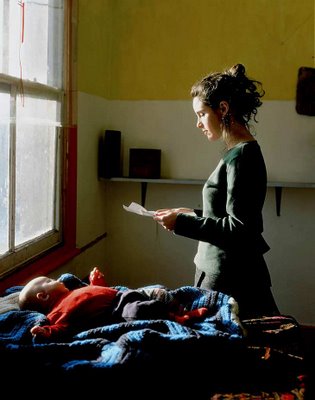 Woman reading a Possession Order, based on Vermeer's "Girl Reading at Window"
Woman reading a Possession Order, based on Vermeer's "Girl Reading at Window"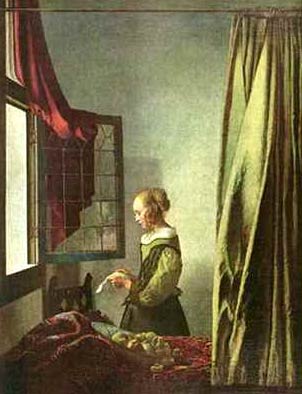
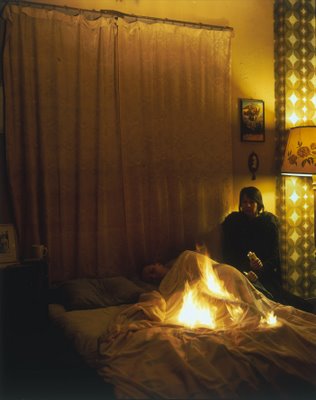
"Lover Set on Fire in Bed"
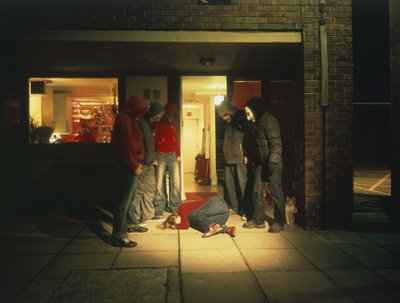
"Hallowe'en Horror: Trick or Treat Thugs break Mum's Bones"
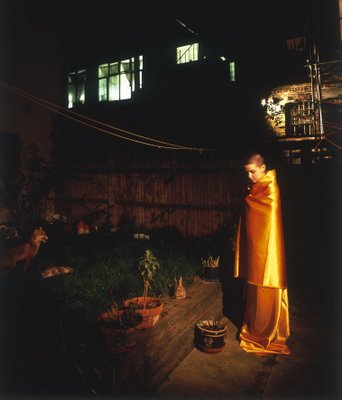
"Bounding Buddhist rushes to the Rescue of Neighbour's Pet"
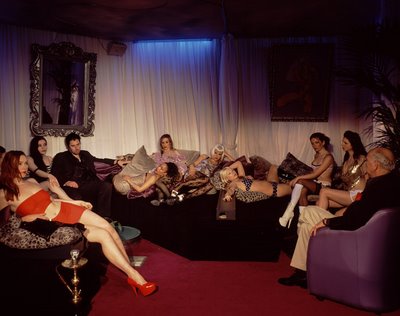
"Father and Son run £2m Vice Racket"

8 comments:
I really like the concept behind these pictures. Tom Hunter’s mix of historical images and contemporary subjects is attention grabbing. I really don’t enjoy going to museums much and just like Hunter said in his interview, it’s because the paintings are things that seem “distant.” We don’t really give them much thought but when you take an image and recreate it with contemporary subjects and objects; we can relate so much easier. We can relate because it doesn’t take a huge leap of imagination to connect with the scenarios because the images are filled with things that we see around us presently. It’s especially fascinating to see Hunter’s image next to the historic work that it is based on. It’s like a history lesson; we can relate to the contemporary piece and its subjects but then we can look at the historic painting and think “so this is now and that is then.” I don’t know if I’m explaining the feeling well enough, but that’s how I feel when I look at them. And I do enjoy looking at these dramatized renderings of modern life more than I would the historic paintings.
The perspective of the original artwork is dramatically different when percieved through these photographs. It brings relevence to their subject matter, not that the originally paintings where not relevant to the people of thier time, but the artist is right. When we go to the DMA for example, we are "spectators", viewing the paintings in reverance, from a distance, as a work of art. However, they are not merely a work of art. They are a depiction of life, one that should be interacted with, and that conjures emotion and reaction from the viewer. By photographing these scences in a re-enactment with a more modern medium, it brings it back into focus, or rather, the interaction of the artwork is percieved differently. Amazing how these depictions in a medium of a photograph can totally alter the interaction of the conceptualization for the viewer.
I'm really impressed by the method in which Tom Hunter not only uses similar subject matter to those addressed in Vermeer's works, but he also seems to take on the artistic style of Vermeer. Jan Vermeer was most notable stylistically for his unique use of light, a new technique that was developing in the Dutch areas of Baroque Europe. He used a great deal of light to illuminate the facial expressions of his subjects. Hunter mirrors this style by emphasizing the amount of light on the young woman's face in "Reading a Possession Order." He also utilizes Vermeer's love for saturated colors through the bright yellow wall, the young woman's green ensemble, and the blue and red fabric around the child.
Interestingly, many of Vermeer's paintings involved a considerable amount of latent sexual content. The Procuress involves a common prostitute being pursued by men, and many of his paintings involve young girls playing instruments, which according to some art historians, denote an invitation directed towards a male suitor. Similarly, Hunter addresses similar issues in "Father and Son Run 2m Vice Racket" although with a much more direct treatment.
I really like how Hunter chose to exhibit his subjects in a way that correlates with poses & styles of well known historical images. On one hand, it educates the viewer on the historical art image if they were not familiar with it prior to viewing. In another sense, I get a relatively same feeling from both images as they relate to one another. Hunter presents his photographs in a way that it can be easy for us to connect with the historical image, whether it be how the subject is positioned on the photo (Woman reading a Possession Order) or how the light is positioned in the photo (Hallowe'en Horror: Trick or Treat Thugs break Mum's Bones). When I first looked at both images, my mind began to race to find the similarities between them. I found that the current image that Hunter took is of course much easier for me to relate to because it is modern day, and found myself examining that image first. After I put myself in the more modern day photo, I then related it to the historical image and thus could then better relate to that one almost as well as I did to the modern day image. In other words, I really enjoy how Hunter presents the two images because I feel this allows us to better connect the two pictures together, instead of simply focusing on the modern day, more familiar one.
Personally I prefer the more "historical" artworks to the contemporary. Artists were more physically involved in their pieces. The artists combined concept and skill so well that many pieces appeared flawless. There are sculptures by Bernini or Michelangelo that you could just stare at and with all its detail it's just amazing that the artist lived through its creation. Considering the amount of dexterity and time dedicated to each piece it is surprising how prolific many of them were. Even the simple anatomical studies of Da Vinci, or Rubens that were used as an aid to their finished pieces are extremely hard to replicate. The amount of natural unaided skill these people had will always be inspiring to me.
With that said, I like the way Tom Hunter incorporates these themes into his contemporary artwork. It encourages people to review paintings of the past that are truly artistic landmarks. He does well in recapturing the essence of the historical piece, while still incorporating his own voice.
I like the Ophelia photograph, "The Way Home." I just love that scene and she's my favorite Shakespearean character. At first I thought Hunter recreated the scene from memory, but then I remembered "Ophelia" by Millais. The photograph differs slightly in the expression of Ophelia, but the setting is the same. It is always interesting to view artists' visual interpretation of classical pieces such as Shakespeare, or even biblical images--things that can be imagined in a countless amount of ways.
Hunter replicates. I don't know if I can view his work with the same esteem as the original artists, but his medium does allow for a beautiful vibrancy in its colors, and sharpness of the figures. I think that adds a great deal to the image, it is an aspect that some of the more historical pieces lacked.
-Shy
It seems that each picture is trying to portray a certain concept, or moral. They take a saying and turn it into something that ordinary people can see, wonder, and learn from. Each one appears to have a sad message however. The lighting, the poses, the subjects all suggest or show that something terrible must have recently happened. The photos really make you wonder about the history behind these people and what they may have done.
What I do not like about the photographs is that it appears that they could have been taken anywhere (i.e. someone's backyard). And perhaps this is the look which was sought, but it does not suit me. I agree with Shyma, I believe it was, who said she preferred the authentic paintings to the contemporary photographs.
I think Hunter did a pretty swell job of his what I like to call, his "remix" of historical images. Kinda just shows that what happened in the present could actually have happened in the past. Though I'm not that big on remakes of songs and movies, I thought the photographs were pretty much well done.
Post a Comment